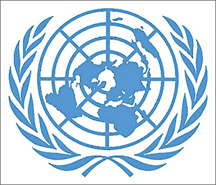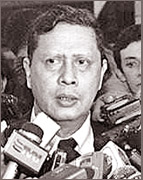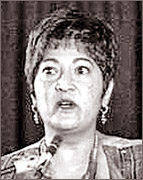UN panel of investigators

The UN panel of experts inquiring in to ‘war crimes in Sri Lanka
during the last stages of the war’ is in the process of finalizing their
report to Ban ki Moon. The three-person panel will be chaired by Marzuki
Darusman. The other two members are Yasmin Sooka of South Africa and
Steven Ratner of the United States.
We wish to bring the following facts and circumstances about these
‘last stages’ so that the experts could bring a semblance of justice and
balance in to bear on their report.

* Sri Lankan Forces were alleged to have killed that 7,000 - 21,000
civilians during the last stages by ‘deliberate firing at the no fire
zones’. The Western media cited ‘reliable sources’ quoting medical
personnel attached to the hospitals in support of this claim. This
‘reliable source’, was none other than the Tamil net which was partisan
and hence could hardly be a ‘reliable source’.
This same Tamil net declared that Prabhakaran was alive and safe
contradicting the Sri Lankan Government’s announcement of his death on
the May 19, 2009 and it was only on May 26 that they admitted his death.
Such was the ‘reliability’ of this source.
* In July 2009, those medical personnel who were quoted in the Tamil
net in May 2009 on ‘mass civilian casualties’ retracted their statements
(now in Government controlled area) and stated that ‘they had to
exaggerate the figures to comply with the LTTE agenda of prompting
Western powers to interfere’.
The BBC and Al Jazeera reported these retracting statements of
medical personnel insinuating that ‘they must be retracting now under
Government pressure’. These channels could only surmise of ‘pressure’
when the medical personnel make statements under the Government but
treat what these same parties said when they were under the fascist LTTE
as ‘reliable’.
This implies that these news channels were conducting an extremely
hostile and partisan campaign against Sri Lanka on this issue for
reasons best known to them.
* The Sri Lankan Government with its past experience in fighting the
LTTE knew all along that the LTTE would try the ‘civilian card’ sooner
or later.
Therefore the Government at the initial stages appointed a
Commissioner General of Essential Services to ensure an uninterrupted
supply of humanitarian needs to the fighting area.
In addition the Government appointed a Consultative Committee on
Humanitarian Assistance (CCHA) headed by the Human Rights and Disaster
Management Minister comprising Senior Presidential Advisor Basil
Rajapaksa, Defence Secretary and the Government Agents of Kilinochchi,
Mulaitivu, Mannar, Vavuniya, Trincomalee and Batticaloa.
* The Government took special care to ensure that they maintain ‘zero
casualty of civilians’ as a policy because twice before the operations
to eliminate the LTTE got mired in controversies over ‘civilian
casualties’ and ‘marooned civilians’.
The Government was also aware of the propaganda outreach of the LTTE
and that it would do its utmost to invoke the Western nations to
interfere in the crisis.
* Further the Government was expecting and was prepared, to house the
civilians during the last phase and if not they could not have coped
with 280,000 influx of civilians at that stage.
The fact remains that 280,000 civilians walked in to the Sri Lanka
Army control area from the clutches of terrorism. Hence no person with
common reasoning will believe that the civilians would do that at the
first available opportunity if the Army had been engaged in ‘deliberate’
or even callous killing of civilians during this time.
* The other point is when you study the battle calendar from January
to May 2009 it is clear that the Sri Lanka Army took only a month to
push the LTTE from Elephant Pass in to the Lagoon via their ‘stronghold’
Kilinochchi and that was the most intensified period of fighting that
there ever was. On the other hand the Forces had to wait from February
to May (three and half months) after having cornered the LTTE in the
lagoon to finally finish them up.
This was because the civilian factor in the lagoon prevented the
Forces from taking combative action. Had the Sri Lanka Army acted with
the same level of fighting efficiency here as they did during the entire
war the LTTE would have been over in February but that would have meant
a few thousands of civilian casualties as well due to the way LTTE
operated under civilian cover in the lagoon.
* As claimed by the Tamil net, if the aggression was only from the
Sri Lanka Forces during this last stage, we may have difficulty in
comprehending how this last stage caused 7,000 deaths of Government
soldiers. Are we to assume that they died by tripping over each other
and not from bullet and bomb wounds inflicted by the LTTE?
* If an average Sri Lankan is five foot and six inches tall and has a
body depth of 30 inches, and if these bodies were heaped into a narrow
sliver of land, it would have found itself to be the size of a
mini-pyramid. Twenty thousand people would be a lot of bodies and to
bury them one would have wanted a sizable grave.
The grave should have been at least 50 metres deep or more. Who
buried these dead bodies and do the IDP’s have any evidence on this? An
infra-red aerial scanner would have spotted this burial ground even now
but they haven’t so far. While the Channel 4 was swift in showing
alleged execution by Sri Lankan soldiers, they seem to have had
difficulty in showing the mountain of the 20,000 dead bodies.
Therefore, the average Sri Lankan would be looking forward to see how
the UN expert panel would explain these anomalies in their report.
Marzuki Darusman

* Attorney General of Indonesia from 1999 to 2001.
* Member of the National Commission of Human Rights in Indonesia (Komnas
HAM).
* Served as Chairman of Joint Fact Finding Commission established in
Indonesia
* Appointed to the Commission of Inquiry to probe assassination of
Benazir Bhutto
* Graduated in 1974 from the International Maritime Law Faculty,
Parahyangan University
Yasmin Sooka
 *
Joined Foundation for Human Rights in 2001 and serves as its Executive
Director. *
Joined Foundation for Human Rights in 2001 and serves as its Executive
Director.
* Practised as a human rights lawyer during the apartheid era.
* Appointed a Commissioner on the Truth and Reconciliation Commission
in 1995
* Acting Judge of the Witwatersrand High Court from 1998-2001
*Appointed by the United Nations to the Sierra Leone Truth and
Reconciliation CommissionInternational Maritime Law Faculty, Parahyangan
University
Prof Steven Ratner
 *
International law of war expert. *
International law of war expert.
* Teaching and research focuses on public international law
* Written and lectured extensively on the law of war
******----------------
[email protected]
|



